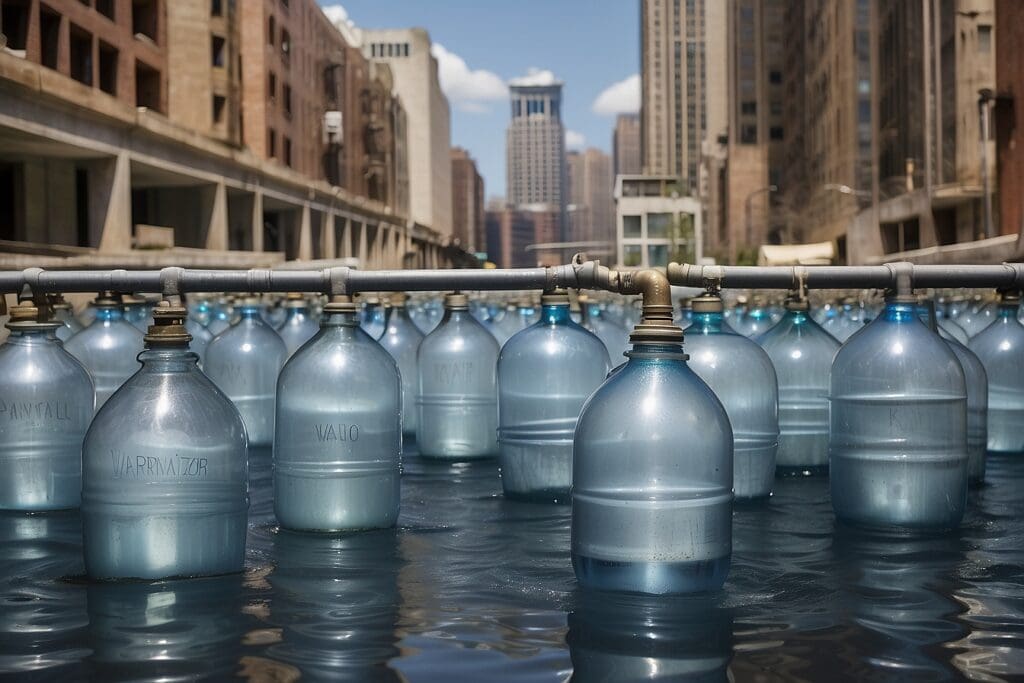Water is one of Earth’s most abundant natural resources. Paradoxically, more than one billion people around the world do not have access to clean water. As the world population grows, this problem is expected only to get worse.1 One popular solution to the problem is water privatization.
The Theory Behind Water Privatization
In theory, privatization would limit those few who abused and wasted common water resources, allowing everyone to moderate their water usage. In practice, privatization often accelerated water waste and exploitation, often causing even more economic and ecological damage. Proponents of privatization argued that inefficient local bureaucracies did not have enough incentive to expand water access to rapidly bourgeoning urban populations.2 Since public water infrastructure has kept the price of water artificially low, farmers can freely exploit limited water resources.
On the other hand, if a private company were in charge of a given water resource, they would try to conserve and reuse it as much as possible. For example, recent innovations have even perfected the water purification process to the point that it now can covert toilet water into completely potable water. Unlike corrupt politicians who limit water access for political favoritism, private companies try to expand their customer base as wide as possible.3
On this principle, the International Monetary Fund and the World Bank imposed conditions on loan packages to encourage countries to privatize. If a country asked one of them for a loan, it had to agree to privatize its water sector. After many countries had privatized their public water infrastructure, an unfortunate pattern emerged. Companies frequently cut off water access to those who could not afford to pay the income-impartial prices. The water price rose dramatically, often resulting in public protest and cancellation of the private contracts. In general, local governments have been left in even more of a mess than when they began.4
Argentina and Water Privatization
Argentina is a prime case of this common water privatization trajectory. Backed by the International Monetary Fund and the World Bank, Argentina privatized water resources for a population of 10 million to a multinational corporation joint venture, Aguas Argentinas. For its first eight years of operation, the company had actually managed a profit of 19%. The World Bank praised it as the water privatization success story. While this was great news for investors, water prices for consumers had risen more than ten times as quickly as inflation rates for the period of 1993 to 2002.5 In 1999, the high prices caused a 30% customer rate of default on payment, which meant the company would cut off these consumers’ access to the water supply.6
To make matters worse, it was later discovered that the company had utilized highly unethical cost-cutting methods. It had failed to fulfill 45% of its contract promises. It had been dumping untreated sewage less than 3 kilometers away from where it was getting its water supply. A study determined that nitrate levels of the water for seven districts were three times too high. Although Aguas Argentinas had originally promised major renovations of the region’s water infrastructure, it instead only fulfilled smaller improvements, leaving many in Buenos Aires still without access to water.7
Opposition to Water Privatization

Critics of privatization say that it is foolish to try to invest in a market where most consumers and private companies may not be able to afford the costs in the first place. Companies had invested because they thought they only had to improve and privatize an existing water infrastructure, when in fact the costs of doing so were much higher than estimated.8 In Bolivia, a large portion of the city was covered, but 200,000 of the 800,000 people living in the city could not afford the price to connect to the company’s water infrastructure.9
However, even in the most advanced and industrialized cities water privatization has had monumental failure. In 1998, United Water signed a contract to exclusively manage the water supply for Atlanta, Georgia. They merely hoped that this would increase efficiency, cut costs, and help to upgrade the dilapidated water infrastructure. Instead, the company soon slashed its workforce, accumulated a backlog of repair orders, and tried to ask the city for $80 million more on its contract. Soon after that, it raised water and sewage rates every year. Only a few years later, the city forced it to move out.
Many observers believe they know why water privatization has seemed to be such a grand failure. As a 2006 United Nations Development Report explained, water sectors must generally be a monopoly for practical reasons. Of course, private water companies work for profit, and they tend to abuse this monopoly on decades-long contracts. Another factor is that supplying water to citizens might simply be unprofitable. Water privatization in countries with high levels of poverty generally means little economic benefit for providing water for a large proportion of the population. Instead of reinvestment into the infrastructure like in public water projects, most of the profit in private water companies goes to outside investors. Economically-disadvantaged citizens end up with a minimal voice in how the system should be prioritized.10
Bottled Water and Water Scarcity
Another unfortunate effect of water privatization is that companies extract and bottle water from resource-rich territories to sell to wealthier customers.11 The Nestle Company often pumps water from springs, bottling a more appealing product to bottled water consumers but simultaneously depleting local streams, farms, and wells.12 In India, one Coca-Cola plant had strained local wells and irrigation so much that farmers had to dig as deep as 450 feet to access freshwater for their crops.13
In fact, the real problem of water scarcity is not that there isn’t enough water to go around.14 The problem is a matter of distribution; 12% of the world uses 85% of its water.15 While the poor do not use much beyond what they need, local companies tend to buy up access to water for industrial purposes or agribusinesses.16 Although the United Declaration of Human Rights has declared food a human right, it did not explicitly mention water. Water is treated as a commodity, and not a need.17
Grassroots Movements
On the bright side, many regions have defied private water companies through grassroots movement. One act of defiance was in Vivendi in Tucumán, Argentina.18 Community organizer Mr. Jorge Abdala mobilized the community to protest water rate hikes by withholding payment for the water. When company representatives came to shut off someone’s water, the other community members would block their way or stood on manhole covers until the person left. After Vivendi ended up with only 10% payment rates in 1998, it pulled out of the project.
It’s entirely possible that water privatization may work under certain conditions. Still, it’s certainly not as much of an all-encompassing solution as it had been promoted. Hopefully, all possible solutions to water scarcity will be considered. It’s important for growing economies,19 freshwater ecosystems, and human lives.





